Microbiology Report: Analysis of a Salmonella Outbreak Case Study
VerifiedAdded on 2023/03/17
|6
|1535
|28
Report
AI Summary
This microbiology assignment analyzes a case study of a foodborne illness outbreak that occurred after a Christmas dinner, where a significant number of participants experienced symptoms of food poisoning. The report identifies Salmonella as the likely causative agent, detailing the common symptoms such as vomiting, abdominal pain, and diarrhea, along with the median incubation period. It compares Salmonella's characteristics with those of other potential bacteria, such as Clostridium perfringens, and explains why Salmonella is the more probable cause. The assignment further explores the potential sources of contamination, focusing on the undercooked turkey meat and the use of contaminated knives. It also provides recommendations for preventing future outbreaks, including proper cooking temperatures, sanitation practices, and food storage guidelines. Finally, the report suggests rapid detection methods, such as lateral flow tests and IMBs-qPCR, for identifying Salmonella in food samples.
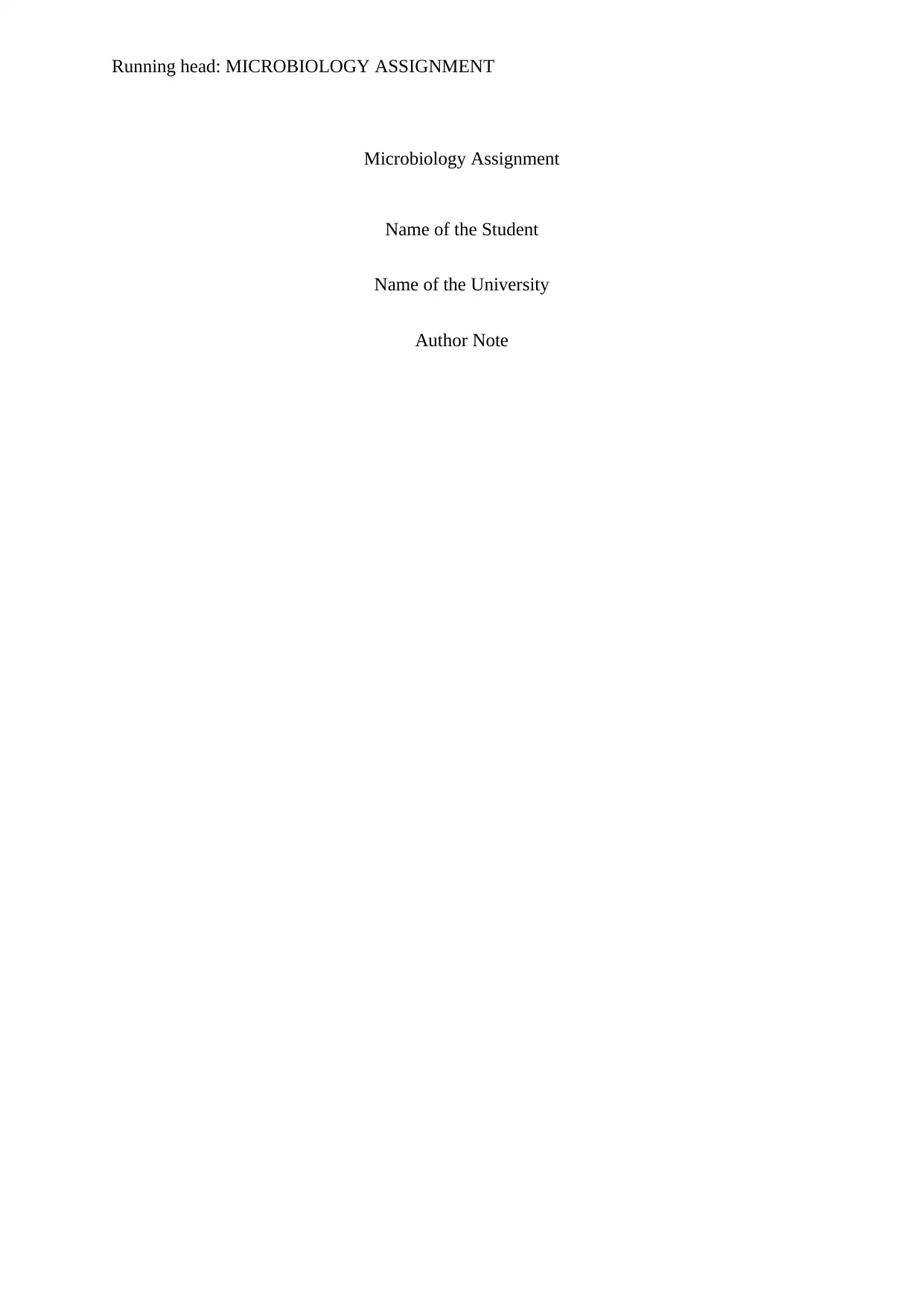
Running head: MICROBIOLOGY ASSIGNMENT
Microbiology Assignment
Name of the Student
Name of the University
Author Note
Microbiology Assignment
Name of the Student
Name of the University
Author Note
Paraphrase This Document
Need a fresh take? Get an instant paraphrase of this document with our AI Paraphraser
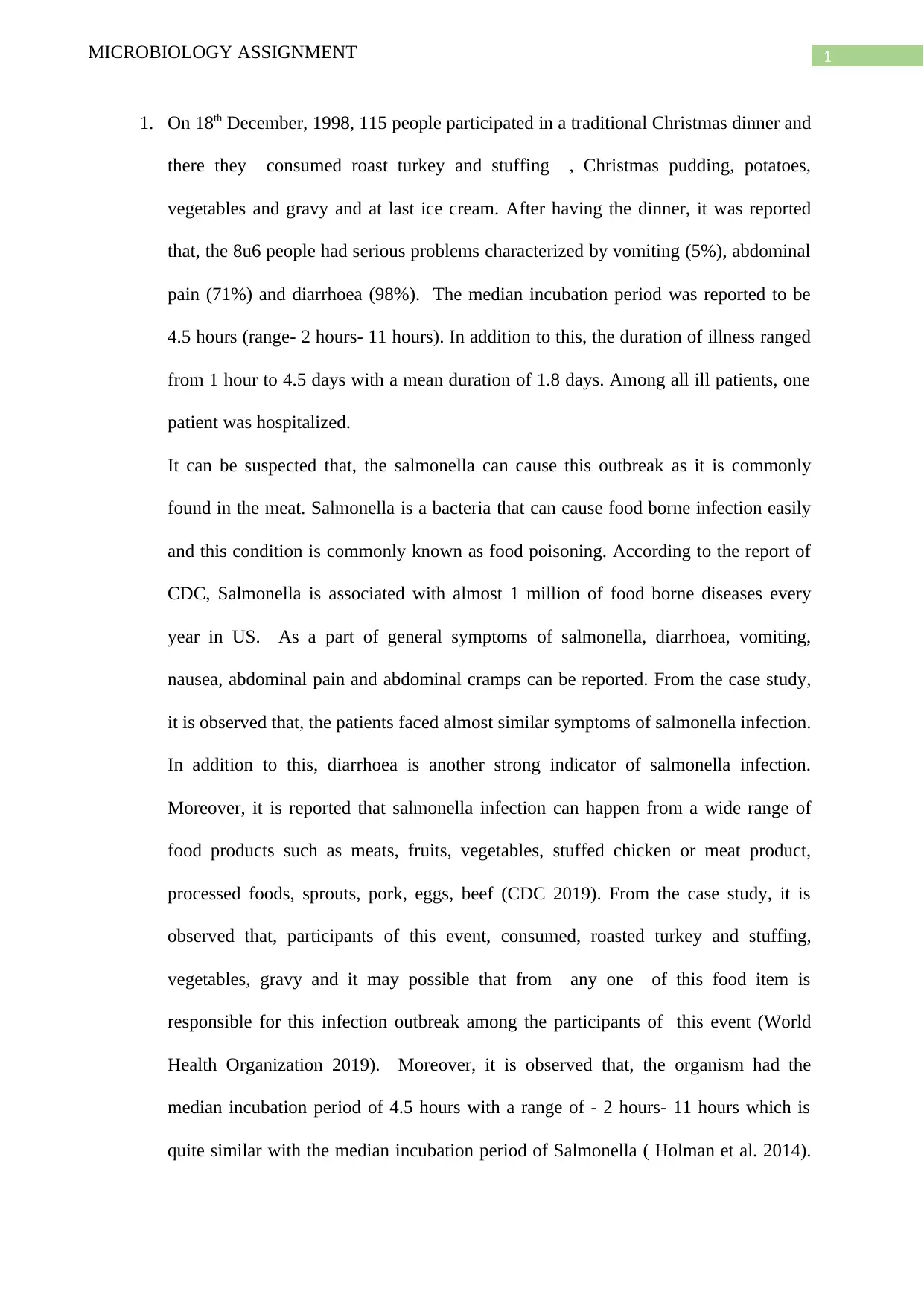
1MICROBIOLOGY ASSIGNMENT
1. On 18th December, 1998, 115 people participated in a traditional Christmas dinner and
there they consumed roast turkey and stuffing , Christmas pudding, potatoes,
vegetables and gravy and at last ice cream. After having the dinner, it was reported
that, the 8u6 people had serious problems characterized by vomiting (5%), abdominal
pain (71%) and diarrhoea (98%). The median incubation period was reported to be
4.5 hours (range- 2 hours- 11 hours). In addition to this, the duration of illness ranged
from 1 hour to 4.5 days with a mean duration of 1.8 days. Among all ill patients, one
patient was hospitalized.
It can be suspected that, the salmonella can cause this outbreak as it is commonly
found in the meat. Salmonella is a bacteria that can cause food borne infection easily
and this condition is commonly known as food poisoning. According to the report of
CDC, Salmonella is associated with almost 1 million of food borne diseases every
year in US. As a part of general symptoms of salmonella, diarrhoea, vomiting,
nausea, abdominal pain and abdominal cramps can be reported. From the case study,
it is observed that, the patients faced almost similar symptoms of salmonella infection.
In addition to this, diarrhoea is another strong indicator of salmonella infection.
Moreover, it is reported that salmonella infection can happen from a wide range of
food products such as meats, fruits, vegetables, stuffed chicken or meat product,
processed foods, sprouts, pork, eggs, beef (CDC 2019). From the case study, it is
observed that, participants of this event, consumed, roasted turkey and stuffing,
vegetables, gravy and it may possible that from any one of this food item is
responsible for this infection outbreak among the participants of this event (World
Health Organization 2019). Moreover, it is observed that, the organism had the
median incubation period of 4.5 hours with a range of - 2 hours- 11 hours which is
quite similar with the median incubation period of Salmonella ( Holman et al. 2014).
1. On 18th December, 1998, 115 people participated in a traditional Christmas dinner and
there they consumed roast turkey and stuffing , Christmas pudding, potatoes,
vegetables and gravy and at last ice cream. After having the dinner, it was reported
that, the 8u6 people had serious problems characterized by vomiting (5%), abdominal
pain (71%) and diarrhoea (98%). The median incubation period was reported to be
4.5 hours (range- 2 hours- 11 hours). In addition to this, the duration of illness ranged
from 1 hour to 4.5 days with a mean duration of 1.8 days. Among all ill patients, one
patient was hospitalized.
It can be suspected that, the salmonella can cause this outbreak as it is commonly
found in the meat. Salmonella is a bacteria that can cause food borne infection easily
and this condition is commonly known as food poisoning. According to the report of
CDC, Salmonella is associated with almost 1 million of food borne diseases every
year in US. As a part of general symptoms of salmonella, diarrhoea, vomiting,
nausea, abdominal pain and abdominal cramps can be reported. From the case study,
it is observed that, the patients faced almost similar symptoms of salmonella infection.
In addition to this, diarrhoea is another strong indicator of salmonella infection.
Moreover, it is reported that salmonella infection can happen from a wide range of
food products such as meats, fruits, vegetables, stuffed chicken or meat product,
processed foods, sprouts, pork, eggs, beef (CDC 2019). From the case study, it is
observed that, participants of this event, consumed, roasted turkey and stuffing,
vegetables, gravy and it may possible that from any one of this food item is
responsible for this infection outbreak among the participants of this event (World
Health Organization 2019). Moreover, it is observed that, the organism had the
median incubation period of 4.5 hours with a range of - 2 hours- 11 hours which is
quite similar with the median incubation period of Salmonella ( Holman et al. 2014).
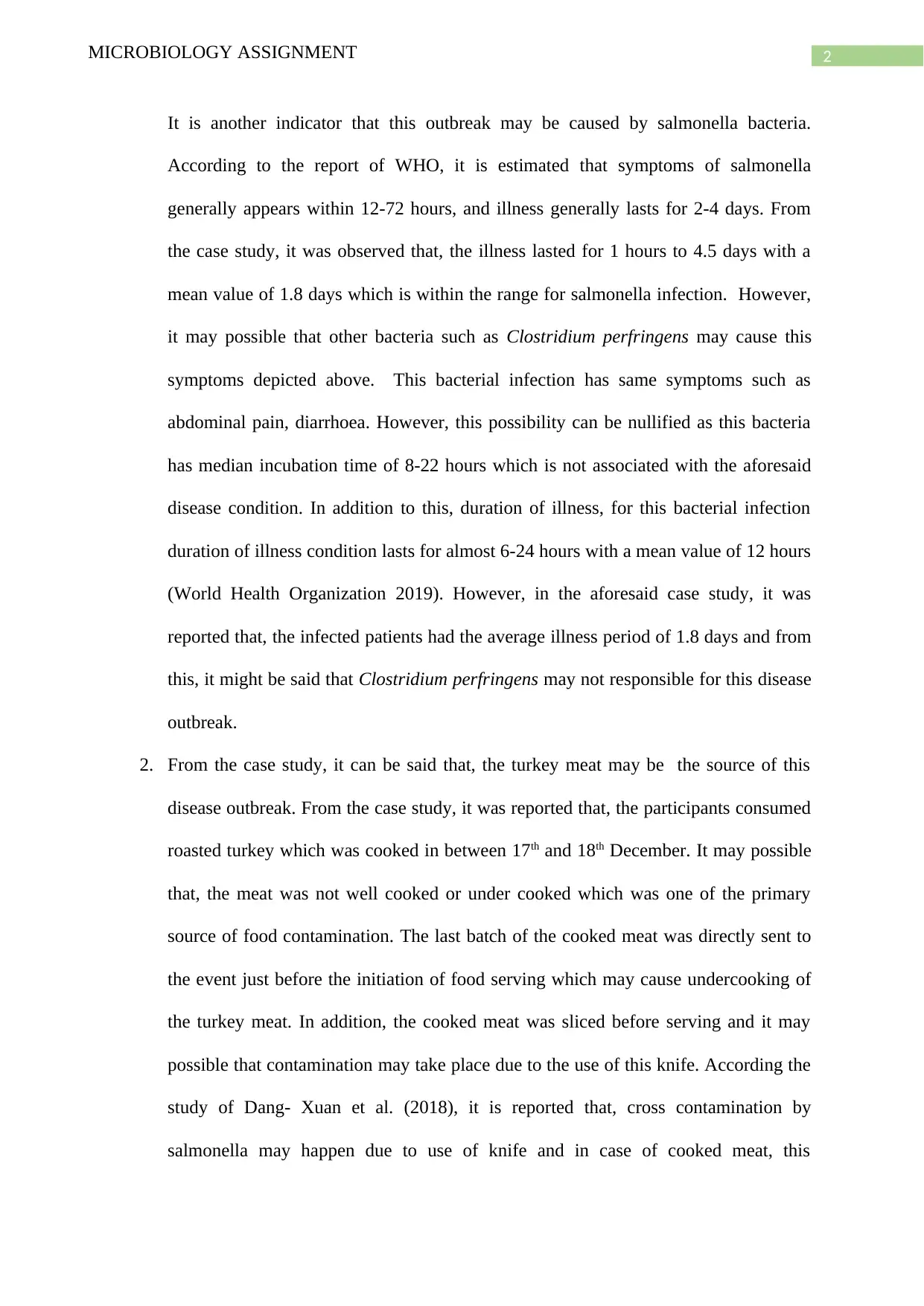
2MICROBIOLOGY ASSIGNMENT
It is another indicator that this outbreak may be caused by salmonella bacteria.
According to the report of WHO, it is estimated that symptoms of salmonella
generally appears within 12-72 hours, and illness generally lasts for 2-4 days. From
the case study, it was observed that, the illness lasted for 1 hours to 4.5 days with a
mean value of 1.8 days which is within the range for salmonella infection. However,
it may possible that other bacteria such as Clostridium perfringens may cause this
symptoms depicted above. This bacterial infection has same symptoms such as
abdominal pain, diarrhoea. However, this possibility can be nullified as this bacteria
has median incubation time of 8-22 hours which is not associated with the aforesaid
disease condition. In addition to this, duration of illness, for this bacterial infection
duration of illness condition lasts for almost 6-24 hours with a mean value of 12 hours
(World Health Organization 2019). However, in the aforesaid case study, it was
reported that, the infected patients had the average illness period of 1.8 days and from
this, it might be said that Clostridium perfringens may not responsible for this disease
outbreak.
2. From the case study, it can be said that, the turkey meat may be the source of this
disease outbreak. From the case study, it was reported that, the participants consumed
roasted turkey which was cooked in between 17th and 18th December. It may possible
that, the meat was not well cooked or under cooked which was one of the primary
source of food contamination. The last batch of the cooked meat was directly sent to
the event just before the initiation of food serving which may cause undercooking of
the turkey meat. In addition, the cooked meat was sliced before serving and it may
possible that contamination may take place due to the use of this knife. According the
study of Dang- Xuan et al. (2018), it is reported that, cross contamination by
salmonella may happen due to use of knife and in case of cooked meat, this
It is another indicator that this outbreak may be caused by salmonella bacteria.
According to the report of WHO, it is estimated that symptoms of salmonella
generally appears within 12-72 hours, and illness generally lasts for 2-4 days. From
the case study, it was observed that, the illness lasted for 1 hours to 4.5 days with a
mean value of 1.8 days which is within the range for salmonella infection. However,
it may possible that other bacteria such as Clostridium perfringens may cause this
symptoms depicted above. This bacterial infection has same symptoms such as
abdominal pain, diarrhoea. However, this possibility can be nullified as this bacteria
has median incubation time of 8-22 hours which is not associated with the aforesaid
disease condition. In addition to this, duration of illness, for this bacterial infection
duration of illness condition lasts for almost 6-24 hours with a mean value of 12 hours
(World Health Organization 2019). However, in the aforesaid case study, it was
reported that, the infected patients had the average illness period of 1.8 days and from
this, it might be said that Clostridium perfringens may not responsible for this disease
outbreak.
2. From the case study, it can be said that, the turkey meat may be the source of this
disease outbreak. From the case study, it was reported that, the participants consumed
roasted turkey which was cooked in between 17th and 18th December. It may possible
that, the meat was not well cooked or under cooked which was one of the primary
source of food contamination. The last batch of the cooked meat was directly sent to
the event just before the initiation of food serving which may cause undercooking of
the turkey meat. In addition, the cooked meat was sliced before serving and it may
possible that contamination may take place due to the use of this knife. According the
study of Dang- Xuan et al. (2018), it is reported that, cross contamination by
salmonella may happen due to use of knife and in case of cooked meat, this
⊘ This is a preview!⊘
Do you want full access?
Subscribe today to unlock all pages.

Trusted by 1+ million students worldwide
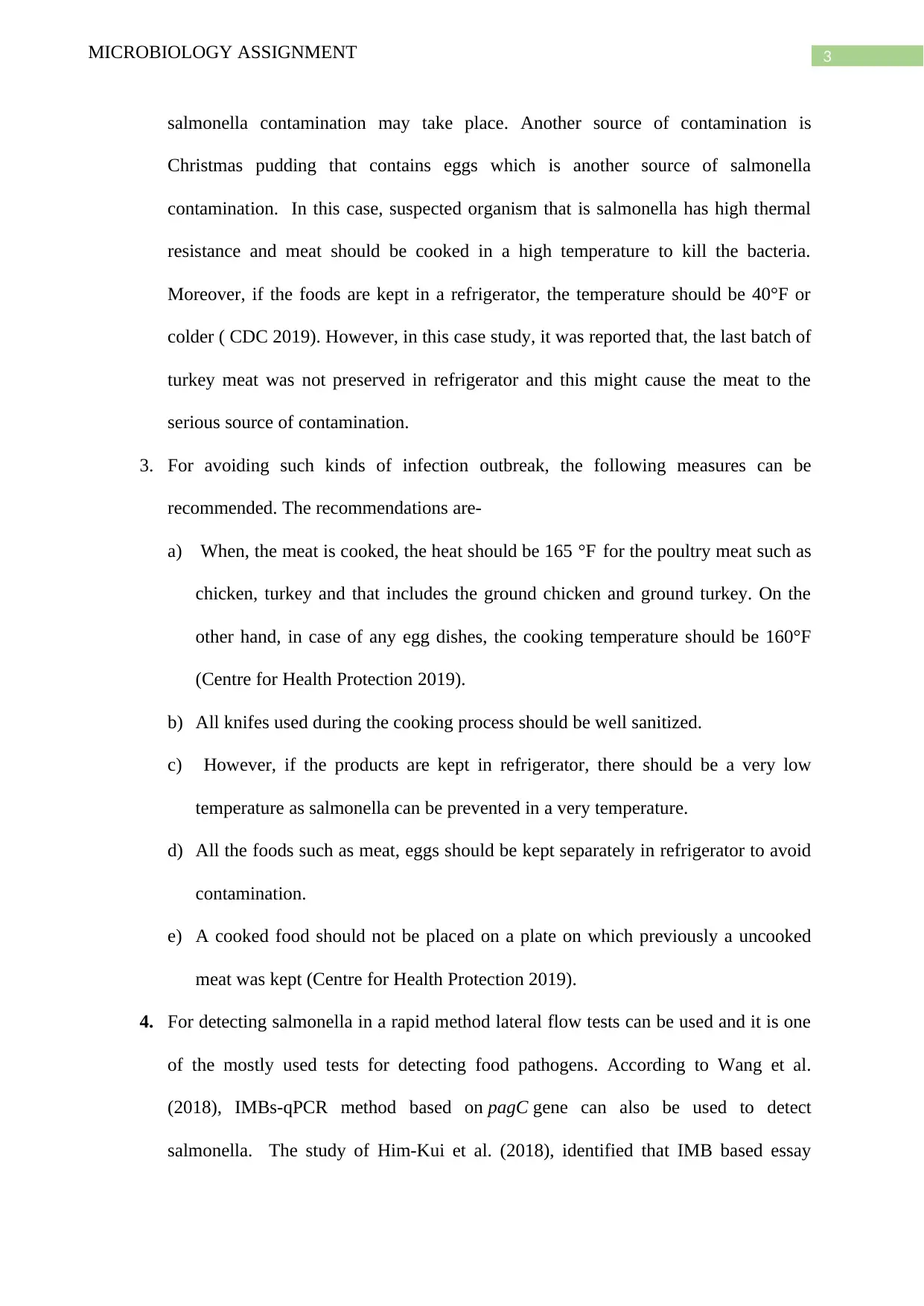
3MICROBIOLOGY ASSIGNMENT
salmonella contamination may take place. Another source of contamination is
Christmas pudding that contains eggs which is another source of salmonella
contamination. In this case, suspected organism that is salmonella has high thermal
resistance and meat should be cooked in a high temperature to kill the bacteria.
Moreover, if the foods are kept in a refrigerator, the temperature should be 40°F or
colder ( CDC 2019). However, in this case study, it was reported that, the last batch of
turkey meat was not preserved in refrigerator and this might cause the meat to the
serious source of contamination.
3. For avoiding such kinds of infection outbreak, the following measures can be
recommended. The recommendations are-
a) When, the meat is cooked, the heat should be 165 °F for the poultry meat such as
chicken, turkey and that includes the ground chicken and ground turkey. On the
other hand, in case of any egg dishes, the cooking temperature should be 160°F
(Centre for Health Protection 2019).
b) All knifes used during the cooking process should be well sanitized.
c) However, if the products are kept in refrigerator, there should be a very low
temperature as salmonella can be prevented in a very temperature.
d) All the foods such as meat, eggs should be kept separately in refrigerator to avoid
contamination.
e) A cooked food should not be placed on a plate on which previously a uncooked
meat was kept (Centre for Health Protection 2019).
4. For detecting salmonella in a rapid method lateral flow tests can be used and it is one
of the mostly used tests for detecting food pathogens. According to Wang et al.
(2018), IMBs-qPCR method based on pagC gene can also be used to detect
salmonella. The study of Him-Kui et al. (2018), identified that IMB based essay
salmonella contamination may take place. Another source of contamination is
Christmas pudding that contains eggs which is another source of salmonella
contamination. In this case, suspected organism that is salmonella has high thermal
resistance and meat should be cooked in a high temperature to kill the bacteria.
Moreover, if the foods are kept in a refrigerator, the temperature should be 40°F or
colder ( CDC 2019). However, in this case study, it was reported that, the last batch of
turkey meat was not preserved in refrigerator and this might cause the meat to the
serious source of contamination.
3. For avoiding such kinds of infection outbreak, the following measures can be
recommended. The recommendations are-
a) When, the meat is cooked, the heat should be 165 °F for the poultry meat such as
chicken, turkey and that includes the ground chicken and ground turkey. On the
other hand, in case of any egg dishes, the cooking temperature should be 160°F
(Centre for Health Protection 2019).
b) All knifes used during the cooking process should be well sanitized.
c) However, if the products are kept in refrigerator, there should be a very low
temperature as salmonella can be prevented in a very temperature.
d) All the foods such as meat, eggs should be kept separately in refrigerator to avoid
contamination.
e) A cooked food should not be placed on a plate on which previously a uncooked
meat was kept (Centre for Health Protection 2019).
4. For detecting salmonella in a rapid method lateral flow tests can be used and it is one
of the mostly used tests for detecting food pathogens. According to Wang et al.
(2018), IMBs-qPCR method based on pagC gene can also be used to detect
salmonella. The study of Him-Kui et al. (2018), identified that IMB based essay
Paraphrase This Document
Need a fresh take? Get an instant paraphrase of this document with our AI Paraphraser
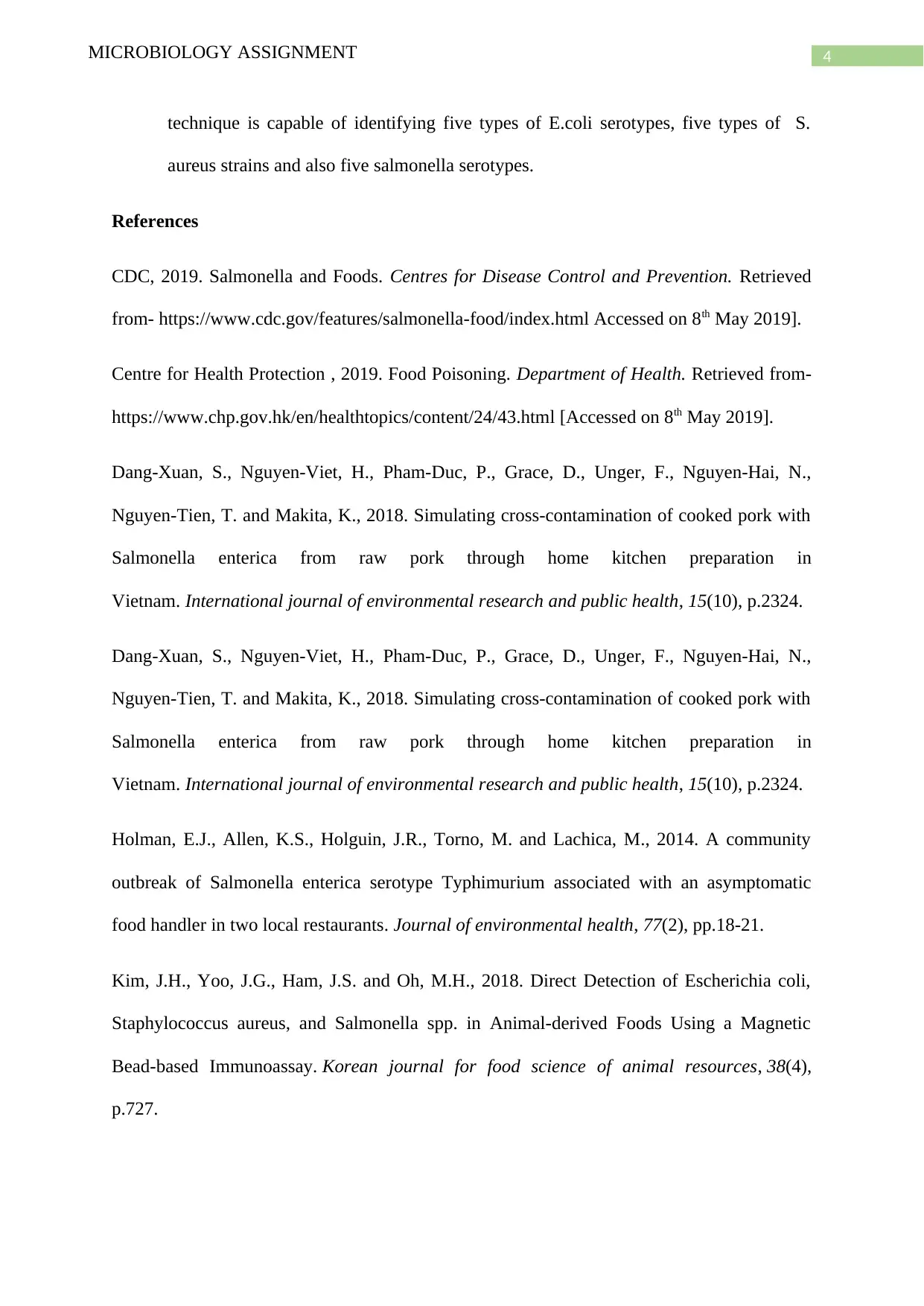
4MICROBIOLOGY ASSIGNMENT
technique is capable of identifying five types of E.coli serotypes, five types of S.
aureus strains and also five salmonella serotypes.
References
CDC, 2019. Salmonella and Foods. Centres for Disease Control and Prevention. Retrieved
from- https://www.cdc.gov/features/salmonella-food/index.html Accessed on 8th May 2019].
Centre for Health Protection , 2019. Food Poisoning. Department of Health. Retrieved from-
https://www.chp.gov.hk/en/healthtopics/content/24/43.html [Accessed on 8th May 2019].
Dang-Xuan, S., Nguyen-Viet, H., Pham-Duc, P., Grace, D., Unger, F., Nguyen-Hai, N.,
Nguyen-Tien, T. and Makita, K., 2018. Simulating cross-contamination of cooked pork with
Salmonella enterica from raw pork through home kitchen preparation in
Vietnam. International journal of environmental research and public health, 15(10), p.2324.
Dang-Xuan, S., Nguyen-Viet, H., Pham-Duc, P., Grace, D., Unger, F., Nguyen-Hai, N.,
Nguyen-Tien, T. and Makita, K., 2018. Simulating cross-contamination of cooked pork with
Salmonella enterica from raw pork through home kitchen preparation in
Vietnam. International journal of environmental research and public health, 15(10), p.2324.
Holman, E.J., Allen, K.S., Holguin, J.R., Torno, M. and Lachica, M., 2014. A community
outbreak of Salmonella enterica serotype Typhimurium associated with an asymptomatic
food handler in two local restaurants. Journal of environmental health, 77(2), pp.18-21.
Kim, J.H., Yoo, J.G., Ham, J.S. and Oh, M.H., 2018. Direct Detection of Escherichia coli,
Staphylococcus aureus, and Salmonella spp. in Animal-derived Foods Using a Magnetic
Bead-based Immunoassay. Korean journal for food science of animal resources, 38(4),
p.727.
technique is capable of identifying five types of E.coli serotypes, five types of S.
aureus strains and also five salmonella serotypes.
References
CDC, 2019. Salmonella and Foods. Centres for Disease Control and Prevention. Retrieved
from- https://www.cdc.gov/features/salmonella-food/index.html Accessed on 8th May 2019].
Centre for Health Protection , 2019. Food Poisoning. Department of Health. Retrieved from-
https://www.chp.gov.hk/en/healthtopics/content/24/43.html [Accessed on 8th May 2019].
Dang-Xuan, S., Nguyen-Viet, H., Pham-Duc, P., Grace, D., Unger, F., Nguyen-Hai, N.,
Nguyen-Tien, T. and Makita, K., 2018. Simulating cross-contamination of cooked pork with
Salmonella enterica from raw pork through home kitchen preparation in
Vietnam. International journal of environmental research and public health, 15(10), p.2324.
Dang-Xuan, S., Nguyen-Viet, H., Pham-Duc, P., Grace, D., Unger, F., Nguyen-Hai, N.,
Nguyen-Tien, T. and Makita, K., 2018. Simulating cross-contamination of cooked pork with
Salmonella enterica from raw pork through home kitchen preparation in
Vietnam. International journal of environmental research and public health, 15(10), p.2324.
Holman, E.J., Allen, K.S., Holguin, J.R., Torno, M. and Lachica, M., 2014. A community
outbreak of Salmonella enterica serotype Typhimurium associated with an asymptomatic
food handler in two local restaurants. Journal of environmental health, 77(2), pp.18-21.
Kim, J.H., Yoo, J.G., Ham, J.S. and Oh, M.H., 2018. Direct Detection of Escherichia coli,
Staphylococcus aureus, and Salmonella spp. in Animal-derived Foods Using a Magnetic
Bead-based Immunoassay. Korean journal for food science of animal resources, 38(4),
p.727.
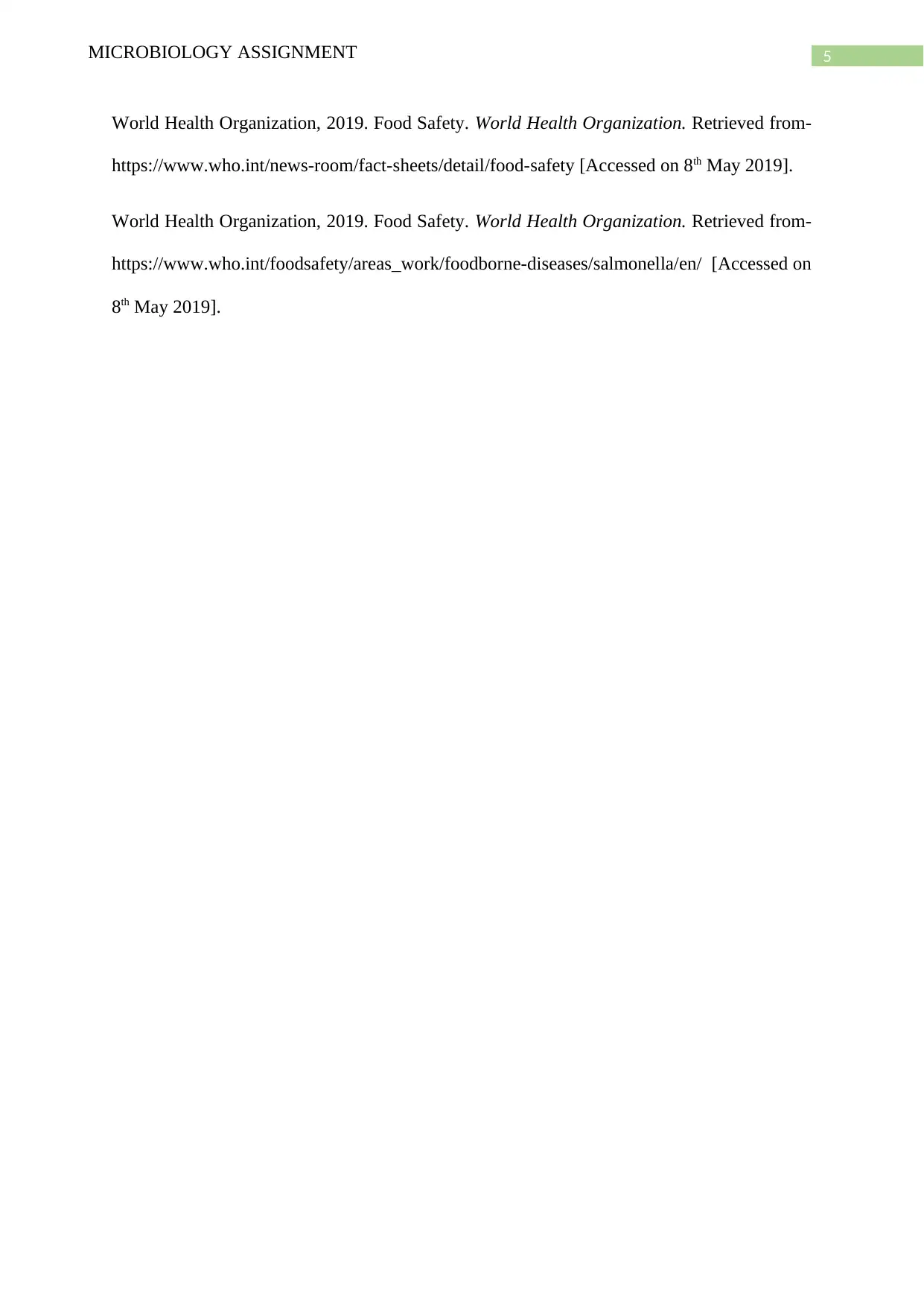
5MICROBIOLOGY ASSIGNMENT
World Health Organization, 2019. Food Safety. World Health Organization. Retrieved from-
https://www.who.int/news-room/fact-sheets/detail/food-safety [Accessed on 8th May 2019].
World Health Organization, 2019. Food Safety. World Health Organization. Retrieved from-
https://www.who.int/foodsafety/areas_work/foodborne-diseases/salmonella/en/ [Accessed on
8th May 2019].
World Health Organization, 2019. Food Safety. World Health Organization. Retrieved from-
https://www.who.int/news-room/fact-sheets/detail/food-safety [Accessed on 8th May 2019].
World Health Organization, 2019. Food Safety. World Health Organization. Retrieved from-
https://www.who.int/foodsafety/areas_work/foodborne-diseases/salmonella/en/ [Accessed on
8th May 2019].
⊘ This is a preview!⊘
Do you want full access?
Subscribe today to unlock all pages.

Trusted by 1+ million students worldwide
1 out of 6
Your All-in-One AI-Powered Toolkit for Academic Success.
+13062052269
info@desklib.com
Available 24*7 on WhatsApp / Email
![[object Object]](/_next/static/media/star-bottom.7253800d.svg)
Unlock your academic potential
Copyright © 2020–2025 A2Z Services. All Rights Reserved. Developed and managed by ZUCOL.
